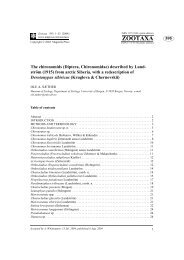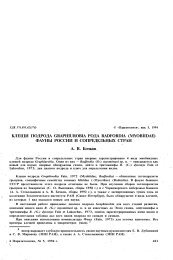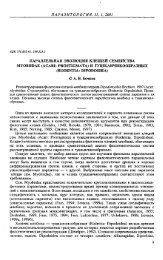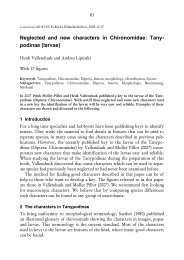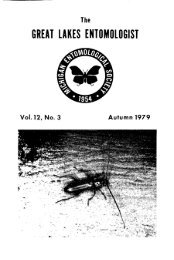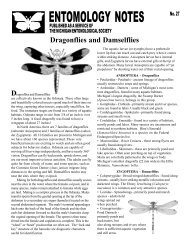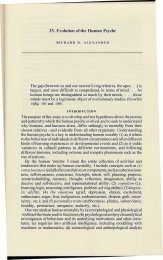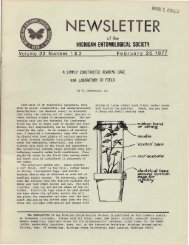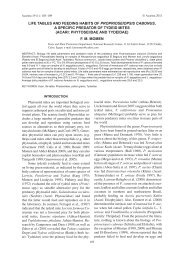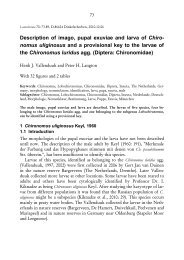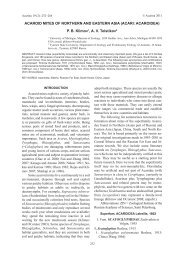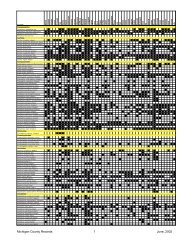Chironomus newsletter on Chironomidae research 22
Chironomus newsletter on Chironomidae research 22
Chironomus newsletter on Chironomidae research 22
You also want an ePaper? Increase the reach of your titles
YUMPU automatically turns print PDFs into web optimized ePapers that Google loves.
of an in situ c<strong>on</strong>trol group of the biota is <strong>on</strong>e of<br />
the limitati<strong>on</strong>s noticed in many c<strong>on</strong>temporary<br />
experimental designs.<br />
In an attempt at overcoming the shortcomings of<br />
comparative studies comprising laboratory and<br />
field samples, our laboratory team has come up<br />
with a novel ex situ technique suitable for rearing<br />
and carrying out simulati<strong>on</strong> studies <strong>on</strong> C. ramosus<br />
in an insectary. This insectary is specially<br />
designed to meet the c<strong>on</strong>diti<strong>on</strong>s as similar as<br />
possible to the prevailing natural envir<strong>on</strong>ment.<br />
Further, rearing is carried out in small water tanks<br />
supplemented with phytoplankt<strong>on</strong> and protists,<br />
thus mimicking the c<strong>on</strong>diti<strong>on</strong>s in a lentic water<br />
body. Of the two tanks inside the insectary, <strong>on</strong>e<br />
serves for ex situ c<strong>on</strong>trol studies and the other for<br />
corresp<strong>on</strong>ding experimental studies in which<br />
stressor c<strong>on</strong>centrati<strong>on</strong>s can be manipulated as per<br />
the requirement of the experimental design. The<br />
insectary is kept covered with a shade net in order<br />
to prevent the entry of other insects. The design<br />
of the insectary is depicted in Fig.1 a-c. This<br />
technique has been successfully standardized for<br />
the maintenance and breeding of C. ramosus and<br />
is cost effective involving less labour input. To<br />
the best of our knowledge, there are no reports of<br />
similar techniques practised for chir<strong>on</strong>omid<br />
midges where natural populati<strong>on</strong>s can be<br />
maintained and subjected to natural seas<strong>on</strong>al<br />
variati<strong>on</strong>s.<br />
The tanks were c<strong>on</strong>structed of clay bricks<br />
reinforced with c<strong>on</strong>crete columns. To begin with,<br />
egg masses collected from the field were reared<br />
and developmental stages were validated for<br />
tax<strong>on</strong>omic identificati<strong>on</strong> using morphological and<br />
cytotax<strong>on</strong>omic keys (Chaudhuri et al. 1992, Nath<br />
and Godbole 1997). To initiate rearing, ≈100 late<br />
fourth instar larvae each were transferred to<br />
rearing tubs (Ø=35 cm) placed in a net cage under<br />
laboratory c<strong>on</strong>diti<strong>on</strong>s (Fig. 1 d), which were<br />
maintained exactly as described by Nath and<br />
Godbole (1998). Similarly, ≈100 larvae were<br />
transferred to the insectary tanks, covered with<br />
net cages and the base of the tanks was layered (2<br />
cm) with silt and finely ground moss that served<br />
as soft substratum for tube building. Special food<br />
formulati<strong>on</strong> (Nath and Godbole 1998) was<br />
supplied to the developing cultures every two<br />
days.<br />
Fig. 1: a) Blue print of the insectary showing the locati<strong>on</strong> of the rearing tanks within the insectary. b)<br />
Interior view of the insectary showing the two rearing tanks. The insectary is shown covered with a shade<br />
net. c) Interior view of the insectary showing the two rearing tanks covered with net cages and each filled<br />
with about 130 litres of water. d) Special laboratory facility for rearing populati<strong>on</strong>s under ambient<br />
laboratory c<strong>on</strong>diti<strong>on</strong>s.<br />
12



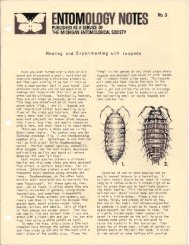
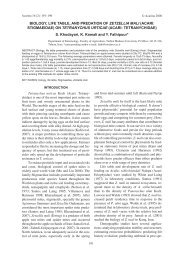
![Williamsonia 1-1 [v4.0] (DR) - Insect Division - University of Michigan](https://img.yumpu.com/18248489/1/190x245/williamsonia-1-1-v40-dr-insect-division-university-of-michigan.jpg?quality=85)
